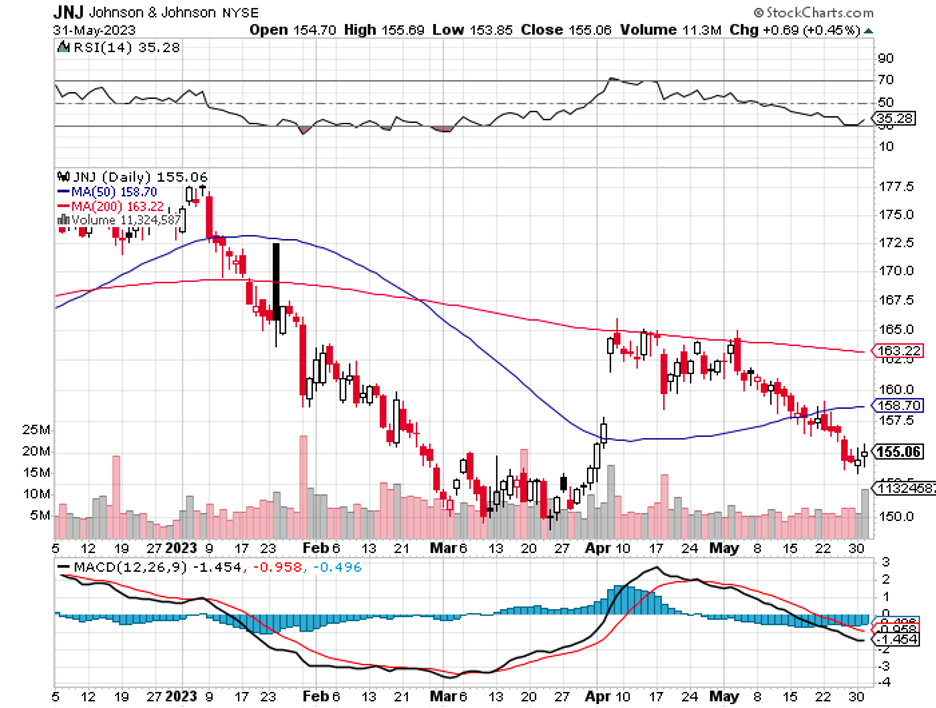If you share Warren Buffett's investment philosophy of favoring enduring companies that deliver long-term performance and passive income to investors, then you'll find yourself drawn to a compelling opportunity that aligns with his principles.
Now, an opportunity presents itself for fans of Buffett's approach.
Johnson & Johnson (JNJ), a favorite of Buffett's, has recently experienced a decline of approximately 13.38% in its share price since the start of 2023, performing noticeably worse than its primary competitors in the healthcare sector, including Eli Lilly (LLY), Novo Nordisk (NVO), and AstraZeneca (AZN).
However, despite this short-term setback, the long-term outlook for Johnson & Johnson remains exceedingly promising.
Actually, J&J has reached a significant turning point as it undertakes a transformative step. The renowned pharmaceutical giant is embarking on a spin-off of its consumer health business into a distinct entity known as Kenvue (KVUE).
While consumer health products like Tylenol painkillers and Band-Aid bandages have become familiar household names, they represent a relatively small portion of J&J's revenue compared to its pharmaceuticals and medtech divisions.
By separating the consumer health business, J&J can strategically focus on bolstering its revenue growth. This move allows the company to prioritize its pharmaceuticals and medtech segments, which have shown robust performance and hold greater potential for expansion.
Consumer health, while essential in everyday life, has experienced slower growth compared to the other two sectors.
In the pharmaceutical arena, J&J boasts an impressive pipeline with over 100 candidates in development.
With the combined strength of its existing blockbusters and promising new products, J&J anticipates a substantial surge in pharmaceutical revenue.
The company aims to elevate its pharmaceutical revenue from the current $52 billion to approximately $60 billion in the coming years, demonstrating a proactive approach to driving growth.
Simultaneously, J&J is actively pursuing opportunities to enhance its medtech division. It recently completed the acquisition of Abiomed, a specialist in heart pumps.
This strategic move now positions J&J with 12 robust medtech platforms, each generating annual sales exceeding $1 billion. Such acquisitions signify J&J's commitment to expanding its medtech portfolio and staying at the forefront of innovation in this vital sector.
Evidently, J&J's decision to spin off its consumer health business into Kenvue reflects a well-informed strategy to optimize revenue growth. With a renewed focus on pharmaceuticals and medtech, supported by a robust pipeline, blockbuster products, and strategic acquisitions, J&J is poised to propel its business to new heights in the evolving healthcare landscape.
Moreover, investors will undoubtedly appreciate Johnson & Johnson (J&J) for its remarkable status as a Dividend King, marking an uninterrupted streak of more than 50 years of dividend increases.
With the stock experiencing an 11% decline this year, a prime opportunity arises to seize passive income and capitalize on the promising growth potential that lies ahead.
Overall, J&J exhibits unwavering financial stability, consistently generating revenue, profits, and free cash flow. This financial resilience is a crucial determinant for sustainable dividend increases over the long term.
Furthermore, the company's impressive AAA rating stands as a testament to its robust balance sheet, reinforcing its ability to weather potential economic downturns, even if the forecasted recession materializes before year-end.
While J&J has faced legal battles in recent years concerning opioids and talc-based baby powder, these challenges will ultimately run their course. The company has proven its resilience time and again, triumphing over adversities throughout its extensive history.
As a Dividend King, the pharmaceutical giant is currently celebrating its 60th consecutive year of dividend increases—a rare accomplishment in the corporate landscape. Presently, the company's dividend yield of 3.03% surpasses that of the S&P 500 at 1.66%.
Although the cash payout ratio of 73% may seem substantial, J&J possesses the necessary tools to sustain its long-standing approach of gradual and steady dividend growth. Investors can find solace in the security of J&J’s payouts, allowing for a good night's sleep as they navigate the markets.


